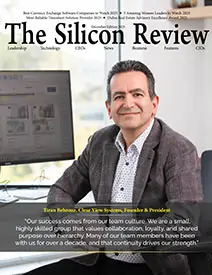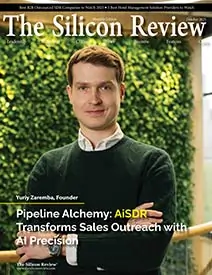>>
Technology>>
It service>>
How Decentralized Web and User...How Decentralized Web and User Control is Providing Alternative Internet Models
The Silicon Review
11 Febuary, 2025
Over the years the internet has evolved into many forms. Having originally started as Web 1.0, offering basic and static web pages, Web 1.0 morphed into Web 2.0, the internet we are now all too familiar with. Web 2.0 is a more interactive internet model, offering enhanced user experiences and promoting user-driven content. Over time the internet reshaped so much of daily life from work, and connecting with family to how people pay bills. Now there is a new radical shift on the horizon, the decentralized web also known as Web 3.0.
Web 3.0 is changing how the internet is used, giving more control back to users. The decentralized web offers a more democratic internet experience and reduces the reliance on big tech corporations and centralized entities. The decentralized web has already brought significant innovations that are gaining momentum from cryptocurrency to decentralized storage. This revolution is more than just an advancement of technology, it is philosophical. It empowers users, ensures privacy, and promotes a fairer and secure digital ecosystem.
A great example of the decentralized web in action is Binance, one of the world’s largest crypto exchanges. The platform offers secure trading of over 400 cryptocurrencies and is largely influential in the world of decentralized finance. Binance embraces the decentralized nature of blockchain technology, constantly innovating to add new features. According to Marina Avramovikj at Techopedia, the platform prides itself on listing projects that comply with regulations and have strong fundamentals. She adds that upcoming Binance coins with moon potential are typically projects that have high trading volumes, signaling significant returns.
This is a great example of how new platforms are being created on Web 3.0 that put user control first. With a focus on security, and only adding projects that have met a specific set of standards. Platforms like this are offering only the best for their users. Binance is working to reshape the world of finance. It shows people a glimpse of what Web 3.0 has to offer in the future. One which prioritizes high-quality and user-focused innovations, whilst empowering investors and beginners alike.
The foundation of the decentralized web is taking back control from big tech conglomerates that assert huge influence over user data and information. Major corporations, for example, search engines and social platforms, own vast amounts of personal information about their users. Web 3.0 is changing this dramatically by leveraging blockchain technology. This decentralizes control, data storage, and application development.
Traditional internet models generally use one centralized server, which is owned by large corporations. However, the decentralized web works across several nodes so no single entity has control over the data that is being shared. The benefits of this are significant for users, who will have more control over their privacy, security, personal information, and Internet activities. This also works to reduce censorship of the web and promotes democratic internet models. With no central point of control, there is also a significantly lower chance of malicious cyberattacks or data breaches.
The main features that define Web 3.0 are decentralization, blockchain technology, user empowerment, and interoperability. The key principle is of course decentralization - the distribution of data and applications across multiple nodes or servers. Blockchain technology is the backbone of the decentralized web. Blockchain has been designed to be a secure and transparent way of storing data and recording transactions.
Blockchain is also a permanent and unchangeable record. No single entity can alter or tamper with the data without permission from other network users. The technology is making an impact on the way people use the internet and is being used across multiple sectors including finance, healthcare, and supply chain management. Blockchain technology has had so much of an impact that the market is expected to grow to 104 billion by 2023.
User empowerment is a key feature of the decentralized web giving control back to users. By using decentralized apps (dApps), users can decide what data they want to share. Web 3.0 offers enhanced privacy and data ownership unlike previous internet models. Another core feature of a decentralized web is interoperability. Users can expect a more cohesive experience with applications designed to interact seamlessly with one another. This means less reliance on centralized operators like banks or social media platforms.
There are many alternative internet models and innovations arising from the decentralized web. It has opened up new possibilities for user control, and shown people how the internet can function in the future. A great example of this is Decentralized Finance (DeFi). DeFi platforms are built on blockchain technology. Users can engage in financial activities without the need for banks or financial institutions. People are now able to seamlessly engage in lending, borrowing, trading, and investing. Users will have full control over their digital assets and financial transactions with no interference from intermediaries.
User control is at the forefront of new internet models on the decentralized web. For example, decentralized social media platforms like Mastadon or Bluesky give users more control over their data and personal information. Unlike traditional social media platforms which are centralized and owned by one company. These platforms will generally control how personal information is stored and shared, and make algorithm decisions or moderate content for the users.
Both decentralized storage and self-sovereign identity (SSI) are other impactful examples of alternative models powered by the decentralized web. Decentralized storage offers users storage systems that work across a network of nodes. This enhances security and makes data more resilient. Self-Sovereign Identity (SSI) allows users to control their digital identity. Users don’t need an intermediary to validate their information. By using blockchain-based credentials that are verifiable, people can prove who they are almost instantly.
Key Takeaways:
- User control is the foundation of the decentralized web, and together they offer a new digital ecosystem that fosters innovation, privacy, and security. Giving power back to the people who use the networks and removing it from centralized entities like corporations or governments.
- The decentralized web works across a network of nodes reducing the reliance on one single server controlled by one corporation. This benefits the user by offering better security, privacy, and control over their data.
- Blockchain technology is the backbone of the decentralized web, offering a new way to conduct transactions that is secure and transparent. This builds trust among network users and offers digital integrity.
- User experience is enhanced on the decentralized web, with seamless integration of applications there is no need for central intermediaries.
- New emerging models like DeFi, SSI, and decentralized social media are offering internet users a change to traditional internet models. With greater control over information and privacy, the ability to conduct financial transactions and ensure that information is stored in a safe ecosystem.
- Innovation is a huge part of the decentralized web, with currency exchanges making a huge impact on traditional financial activities and putting user trust and experience at the front of its projects.
На платформе Мостбет доступны не только спортивные ставки, но и увлекательные игры в казино с живыми дилерами.


_2025-11-17_06-38-14.webp)

 (1)_2025-10-21_13-35-14.webp)

_2025-10-02_10-21-48.webp)